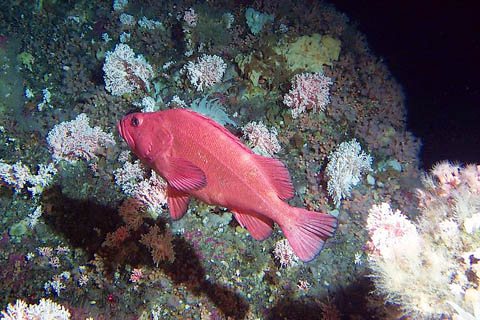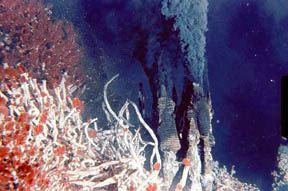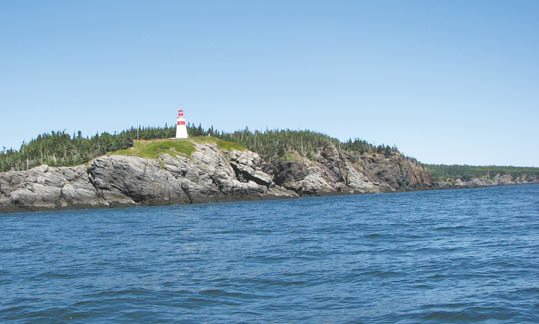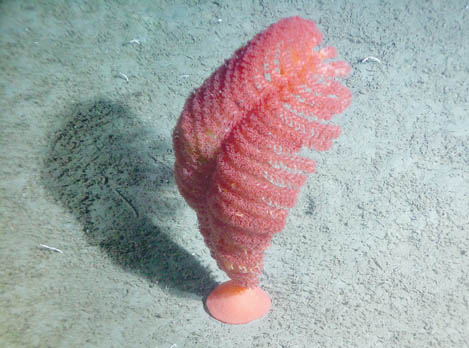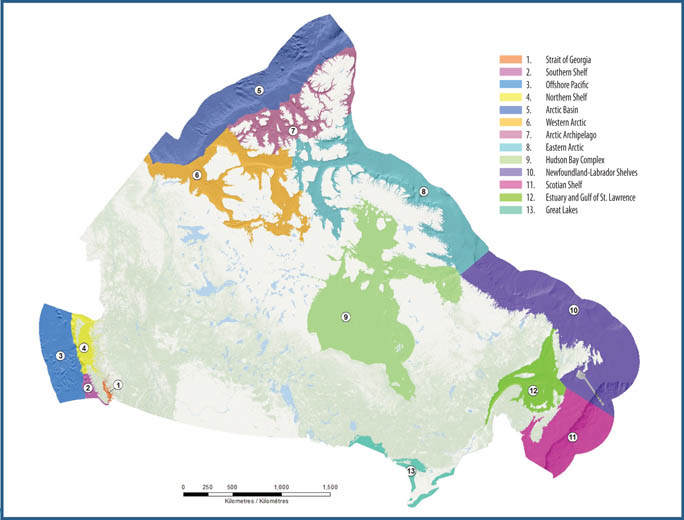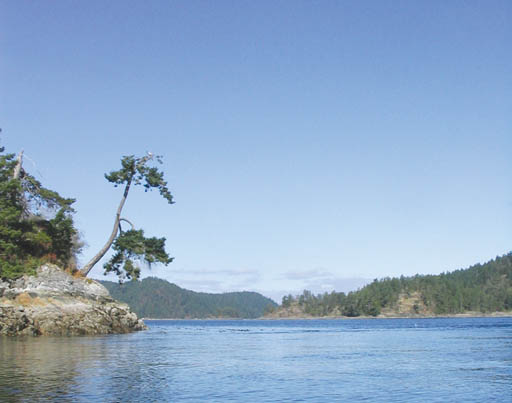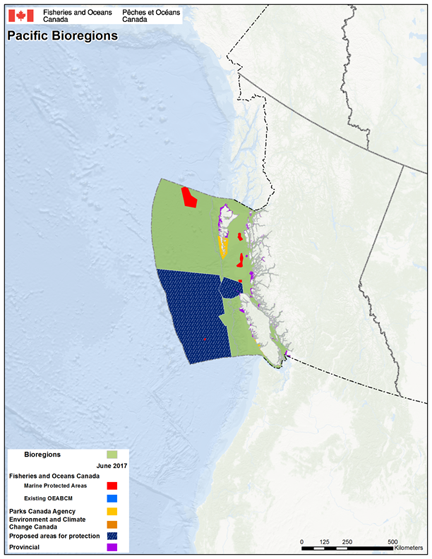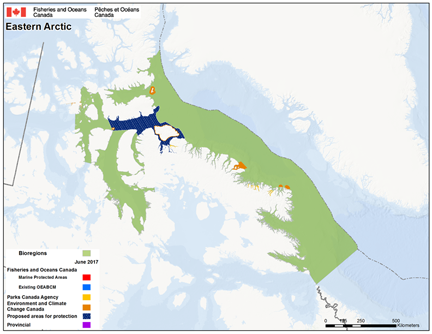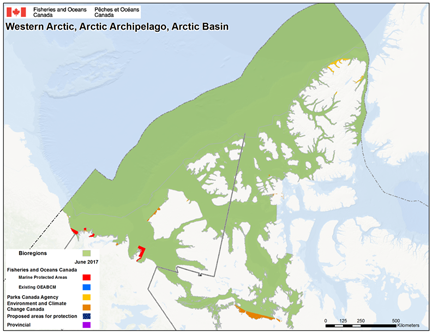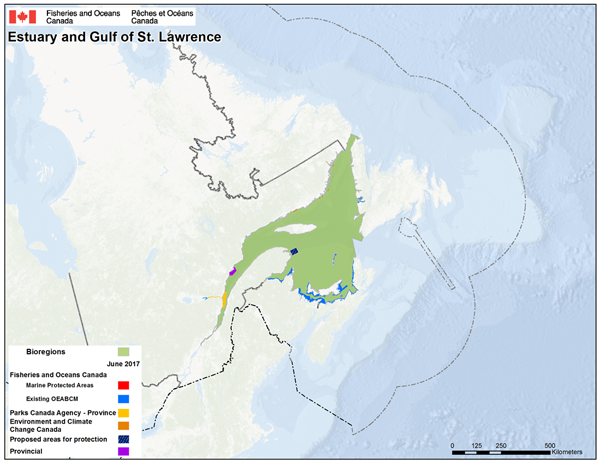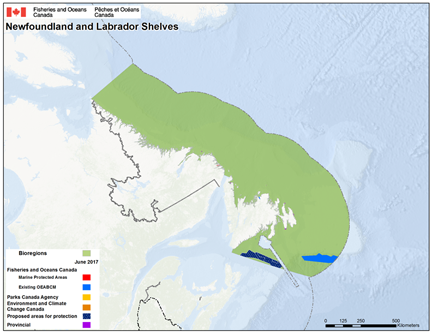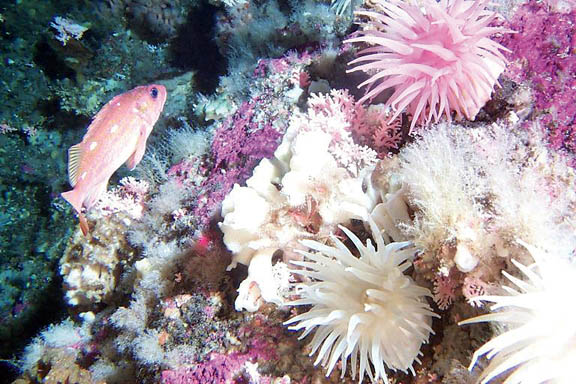Canadian Council of Fisheries and Aquaculture Ministers (CCFAM) Report on Canada’s Network of Marine Protected Areas, June 2017
Table of Contents
- Executive Summary
- Introduction
- The Importance of Healthy Oceans
- Benefits of Marine Protected Areas and Marine Protected Area Networks
- Marine Protected Area Network Planning
- Progress in Priority Marine Bioregions
- Marine Conservation Targets: 2017 and 2020
- Other Effective Area-Based Conservation Measures (OEABCM)
- Conclusion
Executive Summary
In 2011, the National Framework for Canada’s Network of Marine Protected Areas was developed for the Canadian Council of Fisheries and Aquaculture Ministers (CCFAM) to outline a strategic direction for the establishment of a national network of marine protected areas (MPAs). The vision articulated in the National Framework is for “an ecologically comprehensive, resilient, and representative national network of marine protected areas that protects the biological diversity and health of the marine environment for present and future generations.” To achieve this vision, the Government of Canada has committed to increasing marine and coastal protected areas to 5 percent in 2017 and to 10 percent in 2020.
In January 2016, CCFAM re-established the Oceans Task Group (OTG)Footnote 1 to provide guidance on the National Framework.
The purpose of this report is to provide an update on MPA network planning, focusing on progress in five priority bioregions.Footnote 2 The report also highlights the contribution of Fisheries and Oceans Canada (DFO) to other effective area-based conservation measures (OEABCM), to MPA networks, and to meeting the Government of Canada’s commitment to national and international marine conservation targets (MCTs).
In terms of advancing the national network of MPAs, this report highlights progress made on work in five priority bioregions: Pacific Northern Shelf, Western Arctic, Newfoundland and Labrador Shelves, Scotian Shelf, and the Estuary and Gulf of St. Lawrence. Network planning and bioregional governance processes support the establishment of individual MPAs which make progress toward meeting the Government of Canada’s commitment. This planning also provides the long-term platform for identifying future marine areas of protection and will support improved collaborative management of Canada’s oceans.
The OTG recognizes that protecting Canada’s marine and coastal areas requires collective efforts and supports federal-provincial-territorial efforts to work together, in accordance with each government’s jurisdiction and priorities. The role of Indigenous groups as well as coastal communities, marine industry sectors, conservation groups, and the public is also important for advancing the conservation and sustainable use of Canada’s marine resources.
Introduction
In 2011, the National Framework for Canada’s Network of Marine Protected AreasFootnote 3 was developed for the CCFAM to outline a strategic direction, including a national vision and goals, for the establishment of a national network of MPAsFootnote 4.
The Framework’s vision is:
An ecologically comprehensive, resilient, and representative national network of marine protected areas that protects the biological diversity and health of the marine environment for present and future generations.
In January 2016, CCFAM re-established the Oceans Task Group to provide leadership and strategic advice to increase the proportion of Canada’s marine and coastal areas that are protected – to five percent by 2017, and ten percent by 2020.
Jurisdictions are engaging through the OTG to provide guidance on the national network of MPAs in Canada’s oceans to achieve the three overarching goals of the 2011 Framework:
- provide long-term protection of marine biodiversity, ecosystem function and special natural features;
- support the conservation and management of Canada’s living resources and their habitats, and the socio-economic value and ecosystem services they provide; and
- enhance public awareness and appreciation of Canada’s marine environments and rich maritime history and culture.
In 2015, the Federal-Provincial-Territorial Conservation, Wildlife and Biodiversity Steering Group and its Biodiversity Working Group (with input from Indigenous groups and stakeholders) developed the 2020 Biodiversity Goals and Targets for Canada and made a commitment to work together in accordance with each government’s respective jurisdiction and priorities. The 2020 goals and targets reflect the Aichi Targets to which the Government of CanadaFootnote 5 is a signatory:
Target 1 is:
By 2020, at least 17 percent of terrestrial and inland waters, and 10 percent of coastal and marine areas, are conserved through networks of protected areas and other effective area-based conservation measures.Footnote 6
The Importance of Healthy Oceans
The world’s oceans occupy more than 70 percent of Earth’s surface and 95 percent of the biosphere. Oceans, including Canada’s three oceans, continue to face increasing pressures from climate change and human activities.
Canada’s full ocean estate, which goes beyond the Exclusive Economic Zone (EEZ) to encompass the extended continental shelf, covers a surface area of approximately 7.1 million square kilometres. This represents an area equivalent to about 70 percent of Canada’s land mass. Within the EEZ limit, Canada’s oceans cover a surface area of approximately 5.75 million square kilometres.
The ecosystem services provided by our oceans’ biodiversity are facing increasing impacts from climate change, species decline and loss, ecosystem degradation and loss, aquatic invasive species, and harmful effects from waste and other pollutants. These impacts affect the proper functioning of the ecosystem services and jeopardize the biodiversity of our oceans for present and future generations.
Healthy oceans provide ecosystem services
Healthy marine ecosystems support a range of benefits, including vital ecosystem services that provide food and water; regulate floods, drought, land degradation, and disease; and support for soil formation and nutrient cycling. Marine ecosystems also support cultural and recreational activities, as well as providing spiritual, religious, and other non-material benefits.Footnote 7
Our oceans are also essential to climate regulation – for example, through absorption of heat and greenhouse gases. Plankton produces much of the world’s oxygen. Estuaries are one of earth’s most productive ecosystems; they provide species with shelter from predators and stresses, but are highly impacted by human activity. Sponges filter nutrients from water. Protected coastal areas can help maintain the natural buffers needed to mitigate the impact on coastal lands from storm surges and floods as well as prevent erosion and stabilize shorelines. Our oceans provide the habitat needed to support species population growth and recovery, services that are particularly important for aquatic species at risk.
Healthy oceans are important for sustaining our economy
As the Organization for Economic Cooperation and Development notes: “the ocean is the new economic frontier. It holds the promise of immense resource wealth and great potential for boosting economic growth, employment and innovation. And it is increasingly recognized as indispensable for addressing many of the global challenges facing the planet in the decades to come, from world food security and climate change to the provision of energy, natural resources and improved medical care.”Footnote 8
However, with this potential comes the responsibility of ensuring that our marine resources are sustainably managed and marine ecosystems are conserved. Canada’s rich endowment of marine resources supports multiple maritime economic sectors from transportation to aquaculture and fisheries.
The establishment of MPAs and networks of MPAs is integral to managing sustainable and prosperous oceans. MPAs and MPA networks provide mechanisms for achieving overarching protection objectives through a series of linked management actions within an identified Canadian marine bioregion. For example, MPA networks may provide refugia for species or stock recovery and protection which in turn can support fishing sectors. Networks can be structured to support other industries (tourism) or activities (recreation) at bioregional and sub-regional levels. Many maritime sectors (for example, fisheries, aquaculture, transportation, energy) make important contributions to marine protection through sustainable use practices and technology improvements.
Healthy oceans shape Canada’s identity as a maritime nation
Healthy, productive oceans with abundant biodiversity at the genetic, species, and ecosystems levels are important to our shared cultural heritage and our Canadian identity as a maritime nation with three oceans. For Canada’s Indigenous Peoples, our oceans represent a continuous link to the cultural and spiritual practices of their ancestors and offer the promise of healthy communities for future generations.
Healthy oceans depend on strong international cooperation
Building strong partnerships worldwide with other governments, and international and non-governmental organizations (for example, the United Nations Convention on Biological Diversity (UN CBD) and the International Union for the Conservation of Nature (IUCN) creates and supports international platforms for information and knowledge exchange. These platforms enable Canada to learn from and work with like-minded countries and organizations to ensure that our oceans ecosystems remain healthy and vibrant.
Canada, as represented by the Government of Canada, is a party to the UN CBD and a member of the IUCN. We have developed domestic oceans objectives and approaches based on international agreements and resolutions arising from these fora.
In September 2015, the 193 member states of the United Nations adopted the 2030 Agenda for Sustainable Development and its 17 Sustainable Development Goals (commonly referred to as the “Global Goals”).Footnote 9 The Government of Canada is committed to supporting the implementation of these Global Goals.
Benefits of MPAs and MPA Networks
In general terms, individual MPAs are a part of the marine environment (including the oceanic and Great Lakes bioregions in the Canadian context) that is managed “to achieve long-term conservation of nature with associated ecosystem services and cultural values”.Footnote 10 A carefully selected and well-designed MPA can provide localized, site-specific benefits that may:
- maintain the ecological processes that generate ecosystem services;
- protect marine ecosystem structure, functions and recovery;
- improve ecological resilience through restored structures, increased productivity and increased food web complexity;
- protect specific areas containing important biophysical features and processes;
- protect habitats important for providing refugia (for example, for endangered or depleted species), breeding and nursery grounds, rearing and foraging;
- enhance the ability of nearby areas to recover from disturbances, by exporting larvae and adult organisms to those areas;
- support increased size, abundance and diversity of marine species;
- support economic activities that are compatible with MPA objectives, such as fishing, aquaculture, transport, recreation, tourism and education;
- provide sites for marine research and monitoring; and
- maintain areas with important spiritual or cultural heritage value.
A strategically designed MPA network may enhance the benefits of individual MPAs by scaling benefits up to the bioregional level in order to:
- support coordinated ecosystem-based management of marine resources and activities from different federal, provincial, and territorial government agencies;
- provide larger, more abundant, and diverse species throughout the network area;
- help mitigate climate change impacts by preserving and protecting coastal and marine species, ecosystems and habitats that are most critical for carbon storage;
- protect historical sites and other sites of cultural importance;
- increase quality of life in local communities; and
- provide additional benefits where adjacent national networks of MPAs are linked across borders (for example, Canada/U.S.).
A variety of federal and provincial/territorial MPA designations contribute to MPA networks.Footnote 11
Marine Protected Area Network Planning
Canada’s national network of MPAs will eventually be composed of 13 networks in spatially-defined bioregions that cover Canada’s Exclusive Economic Zone (EEZ) and the Great Lakes. Each of the 13 networks will be a collection of clearly defined areas that operate cooperatively in order to achieve the three overarching national goals set out in the 2011 Framework.
These networks are intended to enhance the benefits of individual MPAs, thereby achieving greater ecological outcomes, such as:
- conserved biodiversity and productivity;
- conserved ecosystem processes and habitats;
- protected species at risk and their habitats; and
- enhanced ecosystem resilience.
Ultimately these outcomes support long-term economic prosperity derived from the sustainable use of our marine resources, improved social well-being, and the practice of cultural customs. However, the OTG also recognizes that a well-planned MPA or network needs to be accompanied by ongoing science and monitoring to measure the MPA’s effectiveness at meeting design objectives.
How does network planning work?
As outlined in the 2011 National Framework, individual MPA networks are developed through governance processes in bioregions through collaboration and consultation among federal, provincial and territorial governments and with Indigenous communities, industry and other stakeholders, and academia.
Key elements of MPA network planning include:
Governance: Establishing decision-making and consultation processes to ensure that all parties are identified and engaged in the development of an MPA network at the outset. The participation of government agencies, Indigenous groups, economic stakeholders, environmental stakeholders and other interested parties will vary bioregionally.
Data and Information Gathering: Current MPAs or other spatial conservation measures, as well as existing ecological, social, cultural and economic data and information are collected, mapped and validated. Science needs and data gaps are also identified and prioritized with available and, possibly, new resources. In making these assessments, local and traditional knowledge will be integrated with science.
MPA Network Design: Network objectives and conservation priorities are established based on available data, information gathered, local and traditional knowledge, and stakeholder input. Data gaps continue to be addressed where resources are available. A draft network design is developed that considers the network objectives, the economic context in the bioregion, and the contributions of MPAs and spatial conservation measures that already exist. A network design is refined in consultation with provinces, territories, Indigenous groups, stakeholders and other interested parties.
Implementation: Government agencies, Indigenous groups and industry partners work together to prioritize areas within the final network design for protection; then areas are designated on a site-by-site basis (as resources permit) using the appropriate regulatory or legislative tool. It is in this phase that a process to advance individual MPA sites is put forward, whether as an Oceans Act MPA, a National Marine Conservation Area, a marine National Wildlife Area, provincial parks or reserves, or through another mechanism. All partners work together to incorporate their own conservation measures, taking into account socio-economic and cultural considerations.
Management and Monitoring: Management of individual MPAs within a network is the responsibility of the federal, provincial, municipal or Indigenous body that has the regulatory or legislative authority. Management of bioregional MPA networks varies depending on the governance structures in place in the bioregion. Management activities are ongoing, often in collaboration with local stakeholders and Indigenous groups, to ensure the effectiveness of both the MPAs in meeting their conservation objectives and the bioregional network in meeting its goals. The network and individual MPAs and approaches to their management are adapted, as required, through ongoing research and ecological monitoring.
Compliance and Enforcement: Engaging interested parties in the development of the MPA management approach is a key step to promoting compliance with the conservation objectives and regulatory requirements set for any MPA. Compliance promotion is conducted through education and shared stewardship, monitoring, control, and surveillance activities. Enforcement activities are also carried out across Canada.
Working with Indigenous Groups
Indigenous rights and interests are always considered when advancing MPA network planning and MPA establishment. Many marine areas hold significant cultural value for Indigenous groups and some of these groups may have land claims agreements or treaties in adjacent or overlapping MPAs.
Stewardship partnerships with Indigenous groups, established through agreements, are integral to meeting our common marine conservation goals. Indigenous groups are important partners in science research, knowledge collection and monitoring projects, adding their traditional knowledge perspectives to scientific approaches. In addition, Impact Benefit Agreements may be required to move forward with MPA establishment in some bioregions, subject to individual land claim agreements.
Indigenous protected areas are becoming better known for their unique characteristics and important contribution to biodiversity conservation. Future collaboration with Indigenous groups is needed to better understand these areas and their role in MPA network planning.
Working with Marine Stakeholders
A participatory process with marine industry stakeholders, community groups, conservation groups, the public and others is required to develop and manage MPAs and MPA networks. The process includes ongoing engagement and information exchange with fish harvester groups, aquaculturalists, offshore petroleum boards and oil and gas sector leaders, the marine transportation industry, and other marine resource sectors. Working with a wide range of marine stakeholders generates new knowledge and understanding while helping to identify common goals and alternative options and solutions.
The OTG emphasizes the importance of governments working with Indigenous groups and stakeholders during the development of marine conservation activities.
Progress in Priority Marine Bioregions
Work is advancing in five priority bioregions: Pacific Northern Shelf, Western Arctic, Newfoundland-Labrador Shelves, Scotian Shelf, and the Estuary and Gulf of St. Lawrence. This work will support the establishment of individual MPAs that may count toward the 2020 target, and will provide the long-term platform for identifying future marine areas for protection.
While the identification of MPAs will be the result of network planning processes (outlined above and in the 2011 National Framework), areas outside these priority bioregions may also be identified (for example, in large offshore areas and in the eastern Arctic). Planning in the remaining eight bioregions will advance in consultation with governments, Indigenous groups, and a range of stakeholders.
MPA Network Strategy for the Estuary and Gulf of St. Lawrence Bioregion
In September 2016, Fisheries and Oceans Canada released the Marine Protected Area Network Strategy for the Estuary and Gulf of St. Lawrence Bioregion. The bioregion encompasses the upper estuary, the lower estuary, and the Gulf of St. Lawrence. This MPA network strategy provides a platform for achieving MPA network objectives in a coordinated, coherent, and effective way among all the parties. Indigenous groups and interested parties will be engaged as MPA network development advances. Any projects will be coordinated by the existing bilateral structures, especially the Canada-Quebec Bilateral Group on Marine Protected Areas (BGMPA). The Strategy also supports continued implementation of the Gulf of St. Lawrence Integrated Management Plan (2013).
To develop the Strategy, bilateral consultation and engagement processes have been established with Nova Scotia, New Brunswick, Prince Edward Island, and Newfoundland and Labrador for MPA network-related collaboration. Consultations were also held with Indigenous groups, industry and other stakeholders, and academia.
MPA Network Development in the Newfoundland-Labrador Shelves Bioregion
The Newfoundland and Labrador (NL) Region has been actively engaged in the advancement of the MPA Network for the NL Shelves Bioregion. Consultations on network planning, and gathering and validating various information sources, are ongoing with provincial and other federal representatives, Indigenous groups, industry, and conservation groups.
In consultation with Newfoundland and Labrador and other federal Departments, DFO has developed an MPA Network Strategy and a network plan will be developed in 2017. The Strategy has been endorsed by regional governance committees and has undergone extensive consultations with other federal and provincial departments and agencies, Indigenous groups, industry and conservation groups. The Strategy guides the MPA Network development and the design process intended to identify and prioritize areas for the creation of future MPAs.
MPA Network Development in the Northern Shelf (Pacific) Bioregion
The Province of British Columbia, the Government of Canada and 17 First Nations are implementing the Canada-B.C. MPA Network Strategy to develop an MPA Network Plan in the Northern Shelf Bioregion of B.C. Formal governance arrangements are currently being negotiated. Bioregional network objectives have been developed and finalized, a stakeholder engagement strategy is nearing completion, and technical work is under way. A final network plan is expected to be completed by March 2019, and will be used to identify and prioritize new areas for the establishment of future MPAs.
MPA Network Development in the Western Arctic Bioregion
MPA Network planning is currently underway in the Western Arctic bioregion, a broad geographic area encompassing the waters of the Inuvialuit Settlement Region, as well as the Kitikmeot region of Nunavut. The federal government is working with co-management partners to respect and support the rights and responsibilities guaranteed under two separate settled land claims: the Inuvialuit Final Agreement (1984) and the Nunavut Land Claim Agreement (1993).
Community consultation tours were held in the Spring 2016 and February 2017 to confirm conservation priorities for the MPA Network and provide opportunities for dialogue on marine protection efforts with co-management partners, elders and community members. An MPA Network Action Plan is expected to be ready for implementation by 2019.
MPA Network Development in the Scotian Shelf Bioregion
Bilateral consultation and engagement processes have been established with Nova Scotia and New Brunswick. DFO continues to discuss network development with Indigenous groups, various industry groups, at public open houses, and with other interested groups (for example, conservation and local community groups). More than 120 meetings have been held since October 2015. Part I of the Science Advisory Process was completed in July 2016 and Part II was completed in November 2016.
A draft MPA network design will be ready for consultation with provinces and Indigenous groups by late spring prior to public release in Fall 2017. The design will prioritize two new Areas of Interest for proposed MPA designation by 2020. A full year of consultation is planned on the draft network design.
The following are two examples of bilateral cooperation to advance marine conservation in bioregions.
Canada – British Columbia Marine Protected Area Network Strategy
With over 450,000 km² of internal and offshore marine waters, Pacific Canada is one of the most diverse and productive marine environments in the world. This Strategy is the result of governments working collaboratively with First Nations, local governments, communities, stakeholders and the public. The Strategy’s joint federal-provincial approach to the development of a network of marine protected areas will not only safeguard communities but preserve the beauty and productivity of the ocean.
The Canada-Quebec Bilateral Group on Marine Protected Areas
Established in 2007, the Canada-Quebec Bilateral Group on Marine Protected Areas (BGMPA) was created to ensure a coordinated approach to establishing MPAs that respects the jurisdictions of the Quebec and federal governments. The BGMPA is working on ratifying a cooperation agreement between Canada and Quebec. In 2017, the BGMPA will continue to work on establishing MPAs in, among other places, the estuary of the St. Lawrence River, one of the largest estuaries in the world, and in the Banc-des-Américains, in the Gulf of St. Lawrence.
The OTG recognizes the ongoing MPA network planning in the five priority bioregions and will continue to provide national policy guidance, as appropriate, to advance this work, including in other bioregions.
Marine Conservation Targets: 2017 and 2020
The international context
In 2010, at the 10th meeting of the Conference of the Parties to the UN CBD in Aichi, Japan, the Government of Canada agreed to meet 20 global biodiversity targets by 2020. Aichi Target 11 states:
By 2020, at least 17 per cent of terrestrial and inland water areas and 10 per cent of coastal and marine areas, especially areas of particular importance to biodiversity and ecosystem services, are conserved through effectively and equitably managed, ecologically representative and well-connected systems of protected areas and other effective area-based conservation measures, and integrated into the wider landscape and seascape.Footnote 12
This global commitment was reconfirmed in 2015 by the United Nations General Assembly’s 2030 Agenda for Sustainable Development under Goal 14 to “conserve and sustainably use the oceans, seas and marine resources for sustainable development.”Footnote 13
Goal 14.5 specifically reflects the Aichi Target 11 and states:
By 2020, conserve at least 10 per cent of coastal and marine areas, consistent with national and international law and based on the best available scientific information.Footnote 14
A range of tools to achieve marine conservation targets
Fisheries and Oceans Canada may establish MPAs under the Oceans Act as well as contribute to long-term biodiversity conservation through other effective area-based conservation measures that may be established under the Fisheries Act. These may include fisheries area closures under the Fisheries Act and critical habitat protection under the Species at Risk Act.
Environment and Climate Change Canada contributes to marine protection through marine National Wildlife Areas (NWA) under the Canada Wildlife Act and through marine portions of Migratory Bird Sanctuaries (MBS) under the Migratory Birds Convention Act. Similarly, the Parks Canada Agency develops National Marine Conservation areas (NMCA) under the Canada National Marine Conservation Areas Act, and several National Parks under the Canada National Parks Act contain significant marine components.
Some provincial and territorial designations also offer marine protection. For example, provinces and territories have various authorities to develop measures that support marine conservation, such as conservancies, ecological reserves, heritage areas, sanctuaries, wildlife management areas and special management areas.
Tracking our performance towards our Marine Conservation Targets
The Government of Canada’s marine conservation targets of increasing protection of marine and coastal areas to five percent by 2017 and ten percent by 2020 are ambitious. The baseline for the 2020 target is Canada’s EEZ which is approximately 5.75 million square kilometres. The ten percent conservation target amounts to 575,000 km²; approximately the area of all Atlantic Provinces combined. Given the level of marine protection at the end of 2015, this leaves a gap of 237,500 km² to protect by 2017, and a further gap of 287,500 km² to protect by 2020.
In June 2017, approximately 1.54 percent (88,398 km²)Footnote 15 of Canada’s ocean territory was protected using a range of MPA tools. The following describes the contributions of federal and provincial governments to this level of marine and coastal protection through use of their regulatory authorities (percentages have not been adjusted to reflect areas where two jurisdictions cooperate):
The OTG believes all the responsible agencies should use their mandates, in accordance with each government’s jurisdiction and priorities, in making a meaningful contribution to the 2020 marine conservation target. This effort includes contribution from the five priority bioregions as well as future priority bioregions in the country.
Other Effective Area-Based Conservation Measures
The term Other Effective Area-Based Conservation Measures (OEABCM) is found as part of the UN CBD’s Aichi Target 11 in recognition of the contribution that OEABCM can make to marine biodiversity conservation. International guidance on OEABCM from the IUCN and the UN CBD continues to develop. In the interim, Fisheries and Oceans Canada has developed operational guidance for identifying marine “other measures”.Footnote 16 This guidance has been and will continue to be informed by discussions taking place through the IUCN’s Task Force on OEABCM, the UN CBD’s Subsidiary Body on Scientific, Technical and Technological Advice, and the Canadian Council on Ecological Areas (CCEA).
To support the development of this OEABCM operational guidance, in January 2016, the Canadian Science Advisory Secretariat (CSAS) provided a Science Advisory ReportFootnote 17 that summarizes the characteristics and factors that can be used to determine whether an area-based management measure is likely to provide marine biodiversity conservation benefits. The resulting operational guidance for identifying marine OEABCM includes five broad criteria, and recommends that each measure must meet all five criteria to be identified as a marine OEABCM:
1. Clearly defined geographic location.
The measure must be in a spatially-defined area.
2. Conservation or stock management objectives
The measure must have a conservation or stock management objective AND the objective must directly reference at least one species of regional importance or habitat that is important to biodiversity conservation.
Conservation and stock management objectives have a biological or ecological basis. Directly referencing an important habitat or species in the objective ensures that management decisions are closely linked to that ecological component.
3. Presence of ecological components of interest
Ecological components of interest are the species and habitat(s) that are conserved in a measure. In order for this measure to meet this criterion, the measure must contain at least two ecological components of interest: a habitat that is important to biodiversity conservation AND a species of regional importance that uses the habitat.
4. Long-term duration of implementation
- The measure must either be entrenched via legislation or regulation; or not be entrenched via legislation or regulation but show clear evidence that the management measure is intended for the long-term (minimum 25 years).
- Measures identified as OEABCM will be managed using a long-term adaptive management approach and are expected to be in place year-round for a minimum of 25 years to support long-term biodiversity conservation benefits. This criterion should not be considered an expiry date for OEABCM. The underlying aim is for all reported OEABCM to be in place indefinitely and ideally in perpetuity.
- As licence conditions or variation provisions under the Fisheries Act have provisions that can simplify removal of a management measure, all fishery closures established via those means are not considered to be entrenched via legislation or regulation, and therefore require clear evidence that they are intended for the long-term. This evidence is in the form of a clearly stated long-term management objective documented in an official publication from the responsible authority.
5. The ecological components of interest are effectively conserved
- No human activities that are incompatible with the conservation of the ecological components of interest (the species and habitat(s) identified through criteria #2 and #3) may occur or be foreseeable within the defined geographic location.
- Foreseeable activities generally include activities for which a business plan is in place and there is evidence that the proponent is going to conduct the activity (for example, applications for leases or permits).
- Existing risk-based tools can be used, as appropriate, in conjunction with expert opinion, to assess whether existing or foreseeable activities and their impacts are incompatible with the conservation of the ecological components of interest.
- Ecological monitoring, surveillance, and enforcement are important elements of adaptive management that support effective conservation. Where these management elements are not already in place for an OEABCM, the intention is to introduce these management elements over time.
Canada’s fishing sector makes many significant contributions to marine biodiversity conservation through long-term fisheries area closures (that is, closures of areas within fisheries). Once an OEABCM (such as a fisheries area closure that meets all five criteria) is identified, future management of that OEABCM must adhere to these criteria or the OEABCM status will be revoked in future reporting.
Each OEABCM is monitored to ensure its ongoing conformity with these criteria. Measures will lose their OEABCM status if a new activity in the area is incompatible with biodiversity conservation and if the impacts of this new activity are not mitigated.
Ecological monitoring programs and surveillance and enforcement will be undertaken to support management decisions within an OEABCM, as resources allow.
In addition to MPAs, OEABCM are another area-based management measure to consider when developing bioregional MPA networks because they contribute towards long-term biodiversity conservation. Whether an OEABCM is part of a bioregional MPA network will depend upon the characteristics of the OEABCM and whether it contributes to the bioregion’s specific network objectives.
Area-based and other management measures support and strengthen bioregional MPA networks, even if they do not qualify as OEABCMs. For example, a seasonal fisheries area closure that does not qualify as an OEABCM may be geographically located between an MPA and an OEABCM – serving as a “stepping stone” to protect a particular life history stage of a species (for example, spawning) as that species moves between two areas during the rest of its life history. The potential supporting role of different types of area-based management measures within a bioregional network will vary on a case- by-case basis, depending on the bioregion’s network objectives.
As part of its report on meeting the 2017 marine conservation target, DFO will note the contribution of OEABCM and the biodiversity conservation benefits they provide, according to these criteria. In addition, future fisheries area closures or other OEABCM will be established. The location, management approaches, and size of these future measures will be developed in consultation with provinces, territories, Indigenous groups, stakeholders, and other parties. DFO will review the list of area-based management measures that meet the criteria contained in the Operational Guidance on a periodic basis to ensure that these measures continue to meet the criteria within an adaptive management approach.
The OTG supports DFO in conducting initial analyses to determine how OEABCM may contribute to the 2017 target. The OTG looks forward to working with the Department on how this approach may be improved in advance of 2020, when international guidance on OEABCM is further developed by, for example, the IUCN and the UN CBD.
Conclusion
Protecting Canada’s marine and coastal areas is a collective responsibility
All levels of government, Indigenous groups, industry sectors and coastal communities across Canadian society play an important role in marine and coastal protection, conserving marine biodiversity, and in the sustainable use of marine resources. Continued progress in developing a national network of MPAs and meeting the international marine conservation target will be made through a wide range of efforts by all groups that rely on sustainable marine resources for Canada’s long-term prosperity.
- Date modified:
